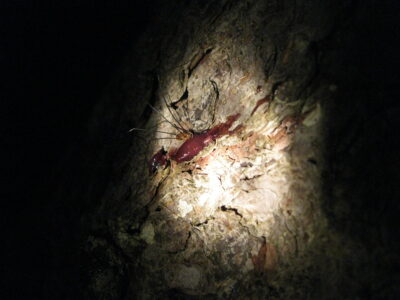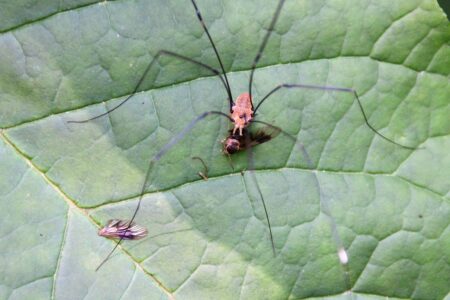Harvestmen Or Daddy Longlegs? Truth Or Myth?
- Harvestmen are often scavengers, like this one that came to eat from moth bait painted on the trees.
- Harvestmen eat small insects and are scavengers. Photo by Jeff Tome

Harvestmen are often scavengers, like this one that came to eat from moth bait painted on the trees.
They have eight long, skinny legs and rounded bodies. They crawl all over trees and logs, finding small insects, plants, and fungi to eat. They go by different names, but the most common one I hear is Daddy-longlegs. They are misunderstood creatures, surrounded by myths and often looked down upon. This is a reputation they do not deserve.
While they are commonly called Daddy-longlegs, that is not their true name. These creatures make up the order Opiliones, but their common name is harvestmen. They are often seen in large numbers in late summer and early fall, as their population soars seasonally. Traditionally this time of year was harvest time, hence the name harvestmen.
Harvestmen are out in abundance right now. It’s hard to walk anywhere at Audubon without running into one of these scurrying little creatures. Audubon day campers are particularly fascinated by them, with a hefty mix of wonder and disgust. I commonly hear them yell “spider!” after finding one crawling on their bag or a nearby log.
This highlights the first, and largest, myth surrounding these creatures. While they do have eight legs and resemble spiders at first glance, they are not spiders. As mentioned before, harvestmen are in the order Opiliones, while spiders are in the order Aranea. Both these groups are arachnids, along with scorpions and mites. All arachnids have eight legs in addition to two extra pairs of appendages near their heads to help with feeding, defense, and sensing their environment. Unlike insects, arachnids do not have antennae or wings. They also have two body segments, while insects have three.
Harvestmen differ from spiders in a few key ways. Spiders have eight eyes, while harvestmen have two. These two eyes are unable to form images, only sensing light and dark. Another key difference is their body shape. Spiders have a distinct separation between their two body parts, causing spiders to look as if they have slim waists. The two body parts of harvestmen are fused together, making their bodies look like a single, round segment. Harvestmen cannot make silk, and therefore cannot make webs. They rely on ambushing their prey rather than catching their prey in a trap.

Harvestmen eat small insects and are scavengers. Photo by Jeff Tome
The last large difference is the way they eat. Spiders are carnivores that eat smaller insects and bugs. They eat by injecting venom into their prey that liquefies and begins to digest the prey before the spider begins to eat. The spider then sucks up the liquid inside their prey. Harvestmen are omnivores, eating insects, plants, and fungi. They do not inject their prey with venom. Instead, they capture their food and eat it in small bites, much like polite humans do.
This brings me to the next common myth I hear about harvestmen. I have been told by many campers and students that harvestmen are the most venomous spiders in the world, their fangs are just too small to bite humans so they can’t hurt us. Scientists have yet to find a single venomous species of harvestmen, and it is not known where that myth originated.
While they sometimes get a bad reputation as being creepy or considered as pests, harvestmen play multiple important roles in the environment. They are predators to the small insects and insect eggs that share their habitat. They are also scavengers, and eat dead and decaying insects, worms, and plants. Some species even eat animal scat.
Harvestmen are incredibly widespread, both in space and time. They are found today on all continents, with the exception of Antarctica. They are also an ancient group of animals. Well preserved fossils of harvestmen were found in 400-million-year-old rock formations in Scotland. These fossils are nearly identical to modern harvestmen, which haven’t changed body structure or general appearance since long before the dinosaurs roamed the earth.
There are many stories about animals that have been passed down from generation to generation for decades. Some of these are true, but many are unfounded. Harvestmen, like many animals, have stories about them that are simply untrue. Sorting the story from the fact can be hard, especially when a loved one taught us the myth at a young age. However, sometimes learning the truth and unlearning the myth has its own reward. Daddy-longlegs are a great example. After all, isn’t it a relief to learn that they aren’t poisonous?
Audubon Community Nature Center builds and nurtures connections between people and nature. ACNC is located just east of Route 62 between Warren and Jamestown. The trails are open from dawn to dusk as is Liberty, the Bald Eagle and other birds of prey. The Nature Center is open from 10 a.m. until 4:30 p.m. daily except Sunday when it opens at 1 p.m. More information can be found online at auduboncnc.org or by calling (716) 569-2345.








